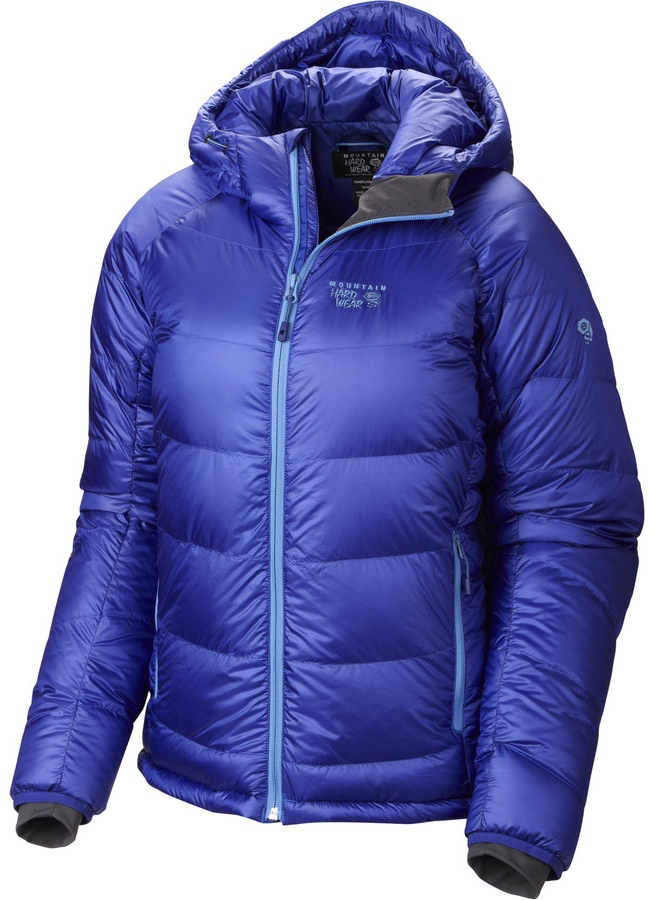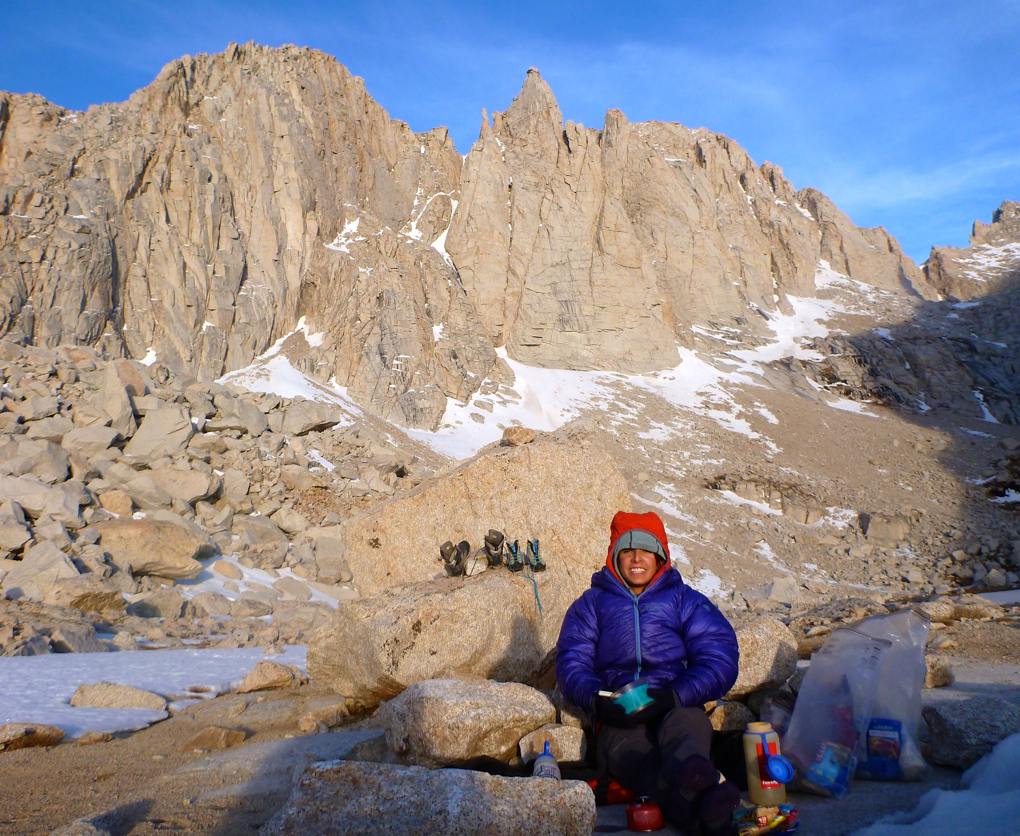
Mountain Hardware Women’s Hooded Phantom Down Jacket
Size Tested: Small
Color: Nectar Blue
Stated Weight: 519 grams
Materials:
- Body Fabric: 20 denier Nylon Rip (100% Nylon)
- Insulation: Q.Shield 850-fill down
Features:
- Baffled Construction
- Two Interior Mesh Pockets
- Two Exterior Zip Pockets
- Elastic Jersey Sleeve Cuffs with Thumb Holes
MSRP: $400
Days Tested: 60+
Locations Tested: Sawatch, Ouray, Silverton, Shelf Road, Crested Butte, Gothic, Elkton, Colorado; Indian Creek, Utah; Eastern Sierra, California
A puffy jacket has the potential to make or break a trip, and sometimes in a life or death sort of way. If the jacket (and particularly its insulation) can’t perform, you’re going to have a hard time meeting your objectives, whether that be nighttime cooking at an established campground, or staying warm while bivvying high in the Cascade Mountains.
Mountain Hardware’s Phantom Hooded Down jacket is a puffy jacket designed to keep you warm, no matter the conditions.
Those looking for insulating pieces have always had to deal with the choice between lighter down insulation that stays warm only when dry, or heavier synthetic insulation that stays warm even when wet.
In areas with predictable weather, you’ve traditionally had to decide how hard it would be to keep your puffy dry, and whether down was worth the effort, or synthetic worth the weight.
But what about in areas with complicated weather patterns, which we’ve seen becoming more and more prevalent in the face of climate change? I want to be able to travel light, but in areas with unpredictable storms, keeping my down dry can be a serious challenge. To deal with this issue, some companies have started making treated, or waterproof, down. Mountain Hardware’s Phantom Hooded Down Jacket uses this sort of waterproof down, and has proven to be an excellent option in this growing category of jackets.
Fit
Mountain Hardwear is known for its slim, petite fit. At 5’1” and 110 pounds, I have always found that I fit well into their apparel. However, I’ve heard many of my normal-sized friends complain that Mountain Hardwear’s clothing has short torso and sleeve lengths. The Phantom Down jacket seems to buck that trend. As a piece of heavy insulation, it is not intended to have a slim cut, or to be particularly form-fitting.
On me, the size Small fits well over multiple layers, but is not overly baggy. The sleeves are actually much longer than those on other Mountain Hardwear pieces I own, and there is more than sufficient coverage in the waist.

In comparison, the Phantom Hooded Down fits slightly smaller and slimmer than the Patagonia Fitz Roy and Black Diamond Cold Forge jackets. However, this difference is not as dramatic than it is in more form-fitting pieces of apparel like mid-weight insulating layers.
Weight and Fill
At 519 grams, the Phantom Hooded Jacket is reasonably light for its class; the Patagonia Fitz Roy Down Parka weighs 481 g, the Black Diamond Cold Forge Parka is 510 g, and the Rab Neutrino Endurance weighs 593 grams.
The Phantom utilizes 850-fill down, which optimizes fill power while minimizing weight. In comparison, the Patagonia Fitz Roy and Rab Neutrino Endurance jackets both use 800-fill down, and the Black Diamond Cold Forge uses a down-synthetic combination. While the Rab Neutrino Endurance has a stitch-through baffle construction, the Phantom uses a fully baffled construction to reduce cold spots that leak heat.
Down Treatment
The Phantom jacket is made with Q.Shield treated down. This is a Durable Water Resistant (DWR) treatment that coats the entirety of the down cloisters, and helps keep the individual down filaments from becoming saturated with water. The treatment allows the down to stay lofted when wet, instead of clumping together and flattening out.
I’ve found that many manufacturers market their hydrophobic down as if it were completely waterproof, and therefore a perfect solution to the ‘wet down problem.’ This is not true, so don’t be fooled. Treated down is not completely waterproof, it just has a DWR treatment on it. So it will still likely clump up and lose some insulating power if you jump in a lake wearing it.
However, I find that treated down, especially the Q.Shield down used in the Phantom jacket, is much more able to withstand damp conditions and pervasive air moisture than standard, untreated down.
Cold, humid conditions can be some of the most miserable and challenging to deal with; when it’s cold and humid, you get chilled down to the bone. And this type of humidity can also make it really hard for a standard down jacket to keep up. If the down gets moist from the damp air, it loses some of its loft, compromising its ability to insulate. While this may not be a big deal on a day trip, if you use untreated down consistently in damp environments (on a multi-day winter camping trip, for example), it will lose some of its loft and will become noticeably less warm.
The Phantom Hooded Down jacket handles this type of weather very well. The treated down stays lofted in humid conditions, helping you to stay warm despite the bone-chilling, wet cold. To prioritize weight, the jacket’s body fabric is water resistant, but not waterproof, like the Fitz Roy, Cold Forge, and Neutrino Endurance. It certainly won’t stay dry if you stand out in the middle of a downpour wearing it, but simply throw on a shell over the Phantom when it’s raining or snowing, and you’ve got yourself a body-warming machine.
Like any DWR-treated raincoat, a water-resistant coating won’t last forever. Over time, these coatings wear off and lose their power to repel precipitation. I am very curious to see how long the Q.Shield down treatment will last, and how noticeable its deterioration will be. So far, I have worn the Phantom through the fall, winter, and spring seasons without any noticeable decrease in performance. The body material of the jacket is a little less water resistant than when I first got it, but so far, I have not been able to detect any decrease in warmth, either when damp or dry.
NEXT PAGE: Warmth and Features…
